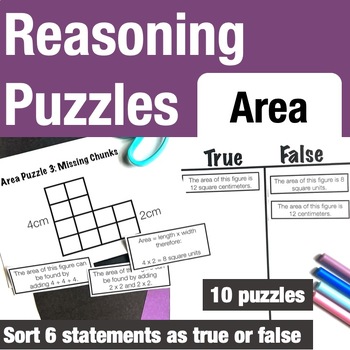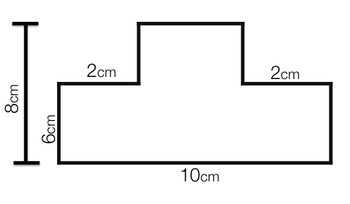Reasoning Puzzles: Area of Irregular Shapes and Rectangles - Tasks for Math Talk
- PDF
What educators are saying
Description
Practice finding the area of regular and irregular rectangles and composites figures with these no prep true/false puzzles. These are great tasks that will supplement your area and perimeter unit lessons. The puzzles get progressively more difficult allowing you to differentiate for your class.
The puzzles begin with regular rectangles with grid lines. Then, they move to irregular composite figures where the grid lines disappear. It's a great way to teach area and have them practice with area models.
These are also great for math warm ups, centers, or early finisher activities? There are 10 no prep puzzles are easy to print and just hand out for instant engagement. In this activity, students decide for themselves whether six statements are true/false about a given puzzle. You can then have them engage in math talk to defend their thinking, and critique the reasoning of others.
Why work on reasoning activities?
The Standards for Mathematical Practice put a focus on the thinking processes of students. There is also some pretty strong research suggesting that students should be engaged in student to student math talk for at least 65% of your math lesson. Giving students these tasks allows them to form their own thoughts, and then work with a team to defend their thinking. If you make it a regular part of your classroom routine (once a week or every other week) students will become more comfortable with math talk.
The puzzles are also fantastic problem solving, critical thinking and deduction activities. This is also a wonderful test prep activity for state testing!
How long does this activity last?
Depending on the ability level of your students, each individual activity can take anywhere from 15 to 30 minutes. There are 10 total puzzles with 6 prompts each in this resource.
How do I assess this project?
You can assess what the students do individually if you have them glue their strips to the true/ false template. If you pull together small groups, you could also assess students on their group work skills and level of participation in their group.
How and when do you use this problem type in class?
There are many ways you can use this activity:
- Fast finisher activity
- Morning work
- Intervention block activity
- Small group work
- Homework for students
- Gifted and talented small groups
- Whole class activity
- Parent volunteers can work one on one
- Center activity
Included in this resource:
1. Information for the teacher pages: CCSS alignment, and a sample lesson plan.
2. True/False Template.
3. 10 puzzles, and 10 answer keys with explanations for the false statements. The puzzles get more difficult as you progress through them.
These puzzles are challenging, and fun! If you have any questions, or find any problems with your purchase, please contact me as soon as possible so that I may fix any errors.
If you like this activity, try out my other reasoning puzzles:





